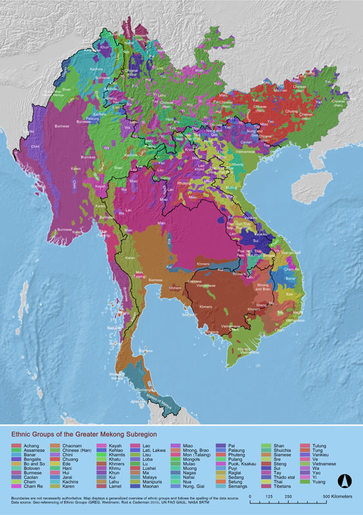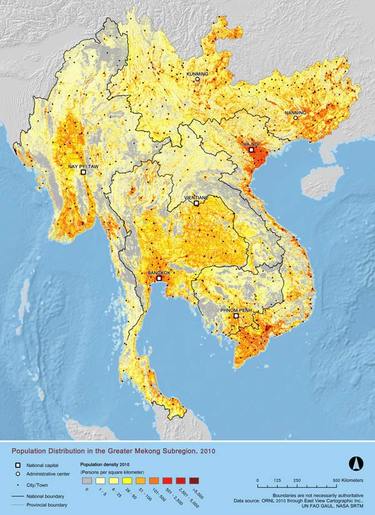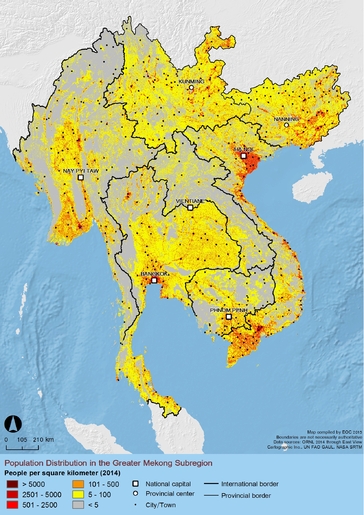-
June 30, 2017ADB
A Region at Risk: The Human Dimensions of Climate Change in Asia and the Pacific
-
February 21, 2017ADB
Safeguarding the Rights of Asian Migrant Workers from Home to the Workplace
-
December 31, 2016CIFOR
CIFOR Priorities 2017: Advancing research for forests and people
-
October 09, 2016ASEAN
ASEAN Strategic Plan for Culture and Arts 2016 – 2025
-
August 01, 2016Asian Development Bank
Greater Mekong Subregion Statistics on Growth, Infrastructure and Trade (Second Edition)
-
June 14, 2016WCS Cambodia
Carbofuran poisoning at the interface between wildlife, livestock and humans.
-
June 14, 2016ESCAP, IOM, ILO, OCHA, UN Women, UNAIDS, UNDP, UNFPA, UNHCR, UN-ACI, UNICEF, UNODC, WHO, World Bank
Asia-Pacific Migration Report 2015
-
May 17, 2016WWF
Natural Connections - How Natural Capital Supports Myanmars People and Economy
-
November 30, 2015RECOFTC
Improving incomes of local people through the sustainable harvesting of timber
-
October 07, 2015WWF
Linking Rapid Erosion of the Mekong River Delta to Human Activities
-
June 30, 2015IGES
Greening Integration in Asia: How Regional Integration Can Benefit People and the Environment
-
November 10, 2014EcoAgriculture Partners
Spatial Planning and Monitoring of Landscape Interventions: Maps to Link People with their Landscapes
-
May 28, 2014GMS Core Environment Program
Climate Change and Rural Communities in the Greater Mekong Subregion: A Framework for Assessing Vulnerability and Adaptation Options
-
May 20, 2014Asian Development Bank
The Environments of the Poor in Southeast Asia, East Asia and the Pacific
-
April 16, 2013Asian Development Bank
ADB Report on Facilitating Safe Labor Migration in the Greater Mekong Subregion
-
8th March 2018
Source: Sixth ToneUnder threats from endangered elephants
-
4th March 2018
Source: Khmer TimesPM: Growing population decreasing forest cover
-
3rd March 2018
Source: The NationTechnology, community and passion – the secret sauce of the smart farmer
-
22nd January 2018
Source: NikkieNearly one billion Asians in vulnerable jobs, says ILO
-
4th January 2018
Source: Khmer TimesCambodia - Youth programme to respond to environment challenges launched
-
2nd January 2018
Source: Phnom Penh PostCambodia - Fishermen seeing fruitful Prahok season, almost doubling last year’s catch
-
28th December 2017
Source: EATERCambodia - When There Are No More Fish
-
20th December 2017
Source: The NationMekong activists demand international law regulating development projects
-
9th December 2017
Source: VietNamNet BridgeVietnam - Mekong provinces link up on water management
-
28th November 2017
Source: The Voice of Viet NamViet Nam - Mekong Delta preserves water-related cultural values
-
25th November 2017
Source: The NationMekong region cities ‘face same problems’
-
19th November 2017
Source: Khmer TimesCambodia - Kirogi typhoon to bring heavy rains, winds
-
19th November 2017
Source: MongabayCambodia - From friends to strangers: The decline of the Irrawaddy dolphin
-
19th November 2017
Source: ADBADB, Lao PDR Sign Agreement to Enhance Sanitary, Phytosanitary Management Systems
-
7th November 2017
Source: Ministry of Environmental ProtectionUNEP: 40 percent of internal conflicts linked to exploitation of natural resources
-
31st October 2017
Source: UNEAThe trucker and the vendor: Mapping gender to boost urban resilience in Laos
-
30th October 2017
Source: Khmer TimesCambodia - Environmentalist to be honoured in New York
-
29th October 2017
Source: The GuardianClimate change already bringing disease, air pollution and heatwaves
-
29th October 2017
Source: National News Bureau of ThailandThailand - Swollen Chao Phraya River prompts preparations in Nonthaburi, Bangkok
-
25th October 2017
Source: Khmer TimesCambodia - Sesan locals agree to new village
-
24th October 2017
Source: Vientiane TimesLao PDR - Low-quality hydropower projects to face void, minister tells assembly
-
24th October 2017
Source: Myanmar TimesMaking Myanmar an energy powerhouse
-
22nd October 2017
Source: Khmer TimesCambodia - Villagers driven to high ground as dam floods
-
17th October 2017
Source: VietNamNet BridgeViet Nam - Hanoi to relocate residents living in flooded areas
-
17th October 2017
Source: Vientiane TimesLao PDR - Govt pledges fairer compensation
-
2nd October 2017
Source: MongabayMyanmar - Second Irrawaddy dolphin death in Borneo linked to fishing nets
-
25th September 2017
Source: Khmer TimesCambodia - PM urges Sesan dam resolution
-
25th September 2017
Source: The Phnom Penh PostCambodia - Sesan dam goes online, while PM dismisses environmental concerns
-
24th September 2017
Source: Khmer TimesCambodia - Inter-governmental effort needed for food safety
-
24th September 2017
Source: Khmer TimesMore than 300 French firms eye Cambodia
-
22nd September 2017
Source: The NationThailand - Lower Mekong dam decision to be appealed
-
14th September 2017
Source: Khmer TimesCambodia - Locals told to leave dam before PM’s visit
-
14th September 2017
Source: Khmer TimesCambodia-Thai-Vietnam bus service
-
13th September 2017
Source: CambodiaCambodia - Factories get environment checks
-
12th September 2017
Source: The NationThailand - Two step forward as smart city pioneers
-
12th September 2017
Source: Lao News AgencyLao PDR - Under Construction Nam Ao Dam Busts
-
12th September 2017
Source: Eco-BusinessMuch of the planet’s land severely degraded owing to increased consumption, UN warns
-
10th September 2017
Source: Myanmar TimesChina-Myanmar gas power plant to be completed on schedule in 2018
-
7th September 2017
Source: The NationThailand joins SE Asia effort on climate change
-
7th September 2017
Source: Myanmar TimesMyanmar - The crane and the Buddha
-
5th September 2017
Source: VietNamNet BridgeViet Nam - Farmers grow more medicinal plants to tap VN's herbal treasure
-
27th August 2017
Source: Khmer TimesCambodia - Changes to make fishing sustainable
-
20th August 2017
Source: VietNamNet BridgeViet Nam - Dong Nai tests electric fence to protect elephants
-
16th August 2017
Source: Khmer TimesCambodia - Storms forecast brings flood alert
-
16th August 2017
Source: Vientiane TimesLao PDR - Govt urges local jobs on Laos-China railway project
-
15th August 2017
Source: Eco-BusinessGet ready for climate impacts beyond your imagination
-
13th August 2017
Source: VietNamNet BridgeViet Nam - Urbanites face health risks from air pollution
-
10th August 2017
Source: VietNamNet BridgeViet Nam - Highlands deforestation continues as forest rangers lose control
-
9th August 2017
Source: ASEANMEDIA RELEASE: Ten conservation advocates receive 2017 ASEAN Biodiversity Heroes Award
-
6th August 2017
Source: Vientiane TimesLao PDR - Flash floods kill two, severely affect residents of Oudomxay
-
2nd August 2017
Source: Eco-BusinessKeeping faith in forests
-
31st July 2017
Source: Ministry of Environmental Protection (MEP)China - Local officials need more environmental awareness
-
30th July 2017
Source: Khmer TimesCambodia - Villagers remain defiant as Sesan Dam waters rise
-
27th July 2017
Source: The NationThailand - Emergency evacuations of at-risk groups amid flooding
-
27th July 2017
Source: Khmer TimesCambodia - More villagers evacuated as floods continue
-
27th July 2017
Source: The Phnom Penh PostCambodia - Community forests fall short
-
26th July 2017
Source: Mekong EyeThailand - Civil society groups denounce new environment bill
-
26th July 2017
Source: Burma News InternationalMyanmar - Thousands displaced and farmland flooded in Thaton District
-
25th July 2017
Source: Eco-BusinessClimate change will force mass migration of 1 billion by 2100
-
23rd July 2017
Source: Khmer TimesCambodia - Airport railway revealed as residents worry
-
21st July 2017
Source: Lao News AgencyMRC Releases Video on Cross Border Water Cooperation among Mekong Members
-
16th July 2017
Source: The Cambodia DialyCambodia - Waiting for the Flood
-
13th July 2017
Source: VietNamNet BridgeViet Nam - Thai Nguyen: uncontrolled mineral exploitation pushes locals to the wall
-
13th July 2017
Source: Eco-Business2016 was the deadliest year ever for environmental defenders
-
11th July 2017
Source: MizzimaMyanmar - About 600 people displaced by flood in Khamti
-
6th July 2017
Source: MRCMRC Launches Regional Photo Contest to Promote Mekong Water Use Cooperation
-
4th July 2017
Source: The NationThailand - Rubber growers ramp up pressure on Prayut govt
-
4th July 2017
Source: Khmer TimesCambodia - Large illegal timber haul seized in Kampong Thom
-
3rd July 2017
Source: Khmer TimesCambodia - Chinese encouraged to invest more
-
1st July 2017
Source: The NationThailand - Powerful politicians ‘threatening’ power plant opponents
-
30th June 2017
Source: MizzimaMyanmar community forestry best practices cited at ASEAN conference
-
28th June 2017
Source: VOACambodia - Fishing Communities Voice Concerns Over Laos Dam as Consultation Ends
-
26th June 2017
Source: Ministry of Environmental Protection (MEP)China - Environmental projects expected to improve quality of life for city's residents
-
21st June 2017
Source: Khmer TimesCambodia - Villagers near Sesan Dam warned to brace for floods
-
20th June 2017
Source: MizzimaMyanmar’s Ayeyarwady Delta sees decline in fish stocks, affecting livelihoods
-
19th June 2017
Source: VOA CambodiaCambodia - Tonle Sap Communities Urge Rejection of Controversial Laos Hydropower Dam
-
18th June 2017
Source: The Phnom Penh PostVietnamese timber trader ‘Grandma May’ flees after order to arrest her
-
15th June 2017
Source: IrrawaddyMyanmar - Coal-Powered Cement Plant Starts Production Despite Local Opposition
-
14th June 2017
Source: The Cambodia DailyCambodia - Villagers Elevate Concerns Over Mekong Dam Construction
-
12th June 2017
Source: Khmer TimesPak Beng consultation: Indispensable and effective despite gaps
-
7th June 2017
Source: Bangkok PostThailand - Pak Beng dam project riles locals
-
5th June 2017
Source: National GeographicReporter’s Notebook: Voices from the Mekong and Tonlé Sap Lake
-
30th May 2017
Source: Myanmar TimesMyanmar - No casualties during Mora cyclone
-
30th May 2017
Source: ADBADB Promotes Harmonized Food Safety, Market Access in GMS
-
29th May 2017
Source: The NationThailand - Safety worries as wild elephants steal from trucks
-
22nd May 2017
Source: The NationAs Asean turns 50, region’s leaders must prepare young generation for the future
-
21st May 2017
Source: Myanmar TimesMyanmar - Two countries one destination with Cambodia planned
-
21st May 2017
Source: EcologistEcologist Special Report: The battle for the ‘mother of rivers'
-
17th May 2017
Source: VietNamNet BridgeViet Nam - Illegal hunter convicted for killing endangered langur
-
17th May 2017
Source: The NationThailand - Authorities rescue people, patients stranded in flash floods in Kamphaeng Phet
-
16th May 2017
Source: Eco-BusinessHow will Southeast Asia feed its people in 2030?
-
15th May 2017
Source: Myanmar TimesMyanmar - Elephant deaths could be linked to poachers
-
15th May 2017
Source: Myanmar TimesMyanmar - Farmers protest distribution of old farmlands
-
11th May 2017
Source: Khmer TimesCambodia - Wildlife charity land dispute rumbles on
-
11th May 2017
Source: The NationThailand - 9,000 migrants return to Thailand
-
10th May 2017
Source: The Phnom Penh PostMekong states sign on to UN policy on drugs
-
9th May 2017
Source: UNEPWorld Migratory Bird Day: A Healthy Planet for Migratory Birds and People
-
7th May 2017
Source: ADBAfter 50 years, Asian Development Bank looks ahead
-
4th May 2017
Source: MizzimaMyanmar coal plant growth could kill 280,000: Study
-
2nd May 2017
Source: Eco-BusinessRenewable energy faces growing human rights concerns
-
29th March 2017
Source: Eco-BusinessDespite growth, one in 10 Asians live in extreme poverty
-
28th March 2017
Source: Vientiane TimesLao PDR - UNICEF supports education, clean water programmes
-
28th March 2017
Source: The NationMyanmar population will reach 65m by 2050 : survey
-
28th March 2017
Source: The Cambodia DialyCambodia - Protesters Seek Answers on Planned Railway Road
-
26th March 2017
Source: Mekong EyeDecision-Makers Must Recognize Irreversible Impacts of Dams on Mekong River and People’s Lives
-
25th March 2017
Source: The NationThailand - Bangkok’s Earth Hour campaign a big success
-
22nd March 2017
Source: Mekong EyeHydropower threatens peace in Myanmar — but it doesn’t have to
-
21st March 2017
Source: Yunnan Environmental Protection Department (YEPD)China - Xi leads ecological civilization
-
20th March 2017
Source: National News Bureau of Thailand (NNT)Thailand - Drought sets off fires across north
-
20th March 2017
Source: Khmer TimesCambodia - Traders urged to use Riel
-
20th March 2017
Source: Channel NewsAsiaASIA'S FUTURE CITIES: Can Bangkok’s ‘green lungs’ survive?
-
19th March 2017
Source: Ministry of Environmental Protection (MEP)China - Government inspection finds hundreds of environmental violations
-
19th March 2017
Source: The Phnom Penh PostCambodia - Ranger station razed by mob
-
19th March 2017
Source: ADBADBNews: ADB President Pledges Strong Support for PRC’s Reforms
-
18th March 2017
Source: Mekong EyeCambodia’s Sambor Dam Plans Causes Controversy as Public Left in the Dark
-
16th March 2017
Source: Mekong EyeU.S. Embassy in Burma recognizes women environmental leaders in Myanmar
-
15th March 2017
Source: Khmer TimesCambodia - First submarine cable launched
-
15th March 2017
Source: The NationThailand - Heatstroke can be fatal – here’s how you can protect yourself
-
13th March 2017
Source: The NationThailand - As wild elephant numbers increase, authorities warn of conflicts with farmers
-
13th March 2017
Source: VietNamNet BridgeViet Nam - Tay Ninh forest threatened by human activity
-
13th March 2017
Source: Eco-BusinessCan Asia achieve zero emissions despite explosive urban growth?
-
9th March 2017
Source: Khmer TimesCambodia - Floating villages to be grounded
-
9th March 2017
Source: The Phnom Penh PostCambodia - Villagers affected by dam meet with government officials
-
9th March 2017
Source: Agence Kampuchea PresseCambodian FM: ASEM Still Faces Some Challenges
-
9th March 2017
Source: The Myanmar TimesMyanmar - Ministry aims at 1 million housing units by 2030
-
8th March 2017
Source: Lao News AgencyLaos Ranks 16th Welcoming Country of the World
-
8th March 2017
Source: The Myanmar TimesMyanmar - Photo exhibit reveals relationship between women, water and hydropower
-
6th March 2017
Source: Ministry of Environmental Protection (MEP)China - Pollution: The silent killer responsible for the deaths of 1.7 million children a year
-
2nd March 2017
Source: Eco-BusinessWhat does water have to do with national security?
-
1st March 2017
Source: VNExpressVietnam's super-rich population is growing faster than anywhere else
-
26th January 2017
Source: MongabayBefore The Flood: Can The Bunong Culture Survive Cambodia’s Sesan Ii Dam?
-
23rd January 2017
Source: ADBADB Infographic - Data Show 50 Years of Changing Asia
-
17th January 2017
Source: ADBADB Article - Population and Aging in Asia: The Growing Elderly Population
-
15th January 2017
Source: MongabaySoutheast Asia’s coal boom could cause 70,000 deaths per year by 2030, report says
-
9th January 2017
Source: Burma News InternationalMyanmar - Challenges in teaching ethnic language in Burma
-
9th January 2017
Source: mizzimaMyanmar - Conserving Protected Indigenous Karen Landscape
-
8th January 2017
Source: ADBADB News - ADB Operations Reach a Record $31.5 Billion in 2016
-
2nd November 2016
Source: ADBADB: Key Indicators 2016 - Fast Data
-
18th August 2016
Source: Ministry of Natural Resources and EnvironmentClimate change and migration in Mekong Delta, Viet Nam: Linkages between climate change and human migration in Mekong Delta
-
16th August 2016
Source: China dailyChina - National park to help ease tension between villagers, big cats



